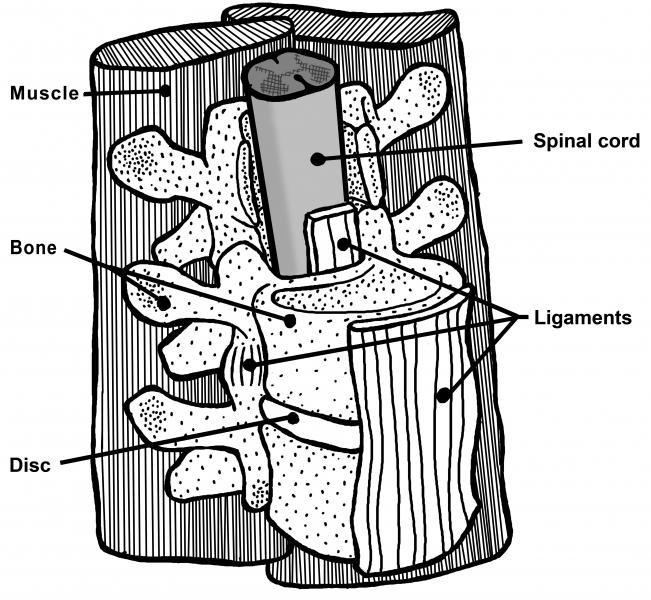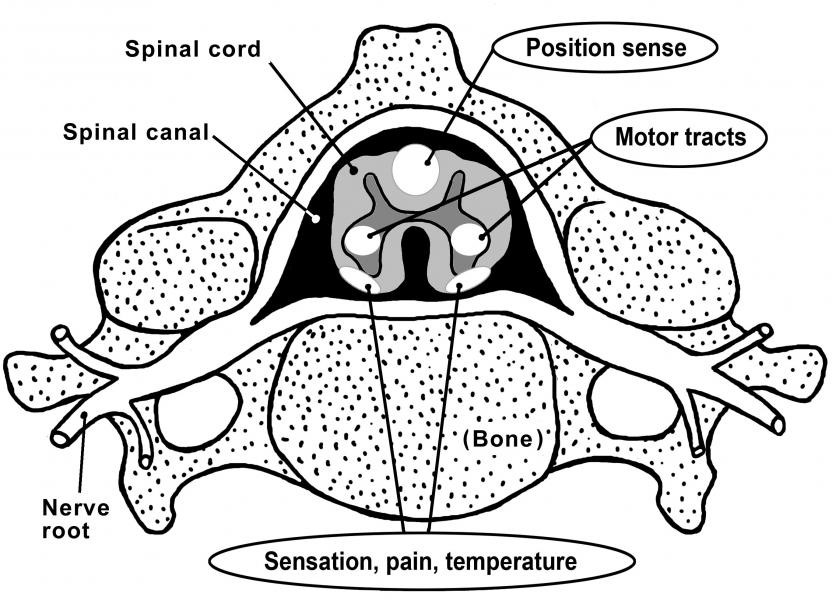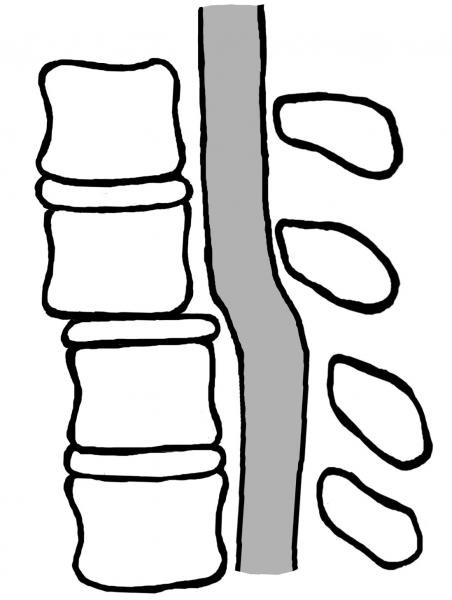What is the central nervous system?
The central nervous system (CNS) controls most functions of the body and mind. It consists of two parts: the brain and the spinal cord. The brain is the centre of our thoughts, the interpreter of our external environment, and the origin of control over body movement. Like a central computer, it interprets information from our eyes (sight), ears (sound), nose (smell), tongue (taste), and skin (touch), as well as from internal organs such as the stomach. The spinal cord is the highway for communication between the body and the brain. When the spinal cord is injured, the exchange of information between the brain and other parts of the body is disrupted.
How does the central nervous system differ from other systems of the body?
Most systems and organs of the body control just one function, but the central nervous system does many jobs at the same time. It controls all voluntary movement, such as speech and walking, and involuntary movements, such as blinking and breathing. It is also the core of our thoughts, perceptions, and emotions.
How does the central nervous system protect itself from injury?
The central nervous system is better protected than any other system or organ in the body. Its main line of defense is the bones of the skull and spinal column, which create a hard physical barrier to injury. A fluid-filled space below the bones, called the syrnix, provides shock absorbance.
Why can’t the central nervous system repair itself after injury?
Many organs and tissues in the body can recover after injury without intervention. Unfortunately, some cells of the central nervous system are so specialised that they cannot divide and create new cells. As a result, recovery from a brain or spinal cord injury is much more difficult.
The complexity of the central nervous system makes the formation of the right connections between brain and spinal cord cells very difficult. It is a huge challenge for scientists to recreate the central nervous system that existed before the injury. The use of Mesenchymal Stem Cells (MSCs) in Spinal Cord Injury have the ability to stimulate repair processes in spinal cord injury are due to the paracrine secretion of the stem cells.
How does the spinal cord work?
The brain and the spinal cord work together. The spinal cord is the link between the brain and the nerves in the rest of the body.
What does the spinal cord allow the body to do?
- Move
- Feel hot and cold temperature, vibration, sharp, and dull sensations
- Sense the position of your arms and legs
- Control blood pressure, heart rate, and body temperature
- Control bodily functions, such as breathing, urination (peeing), and bowel movements
When the body moves, messages travel from the brain down the spinal cord. Messages also are carried up the spinal cord to the brain so a person can feel sensations.
There are nerves that branch off the spinal cord. They are called spinal nerves. The nerves are divided into five main sections (from top to bottom): cervical, thoracic, lumbar, sacral, and coccygeal. The spinal cord and nerves are very fragile.
How is the spinal cord protected?
 View from front to back of spine and spinal cord (Back of spine)
View from front to back of spine and spinal cord (Back of spine)
The spinal cord is protected by bones, discs, ligaments, and muscles. The spine is made of 33 bones called vertebrae. The spinal cord passes through a hole in the center (called the spinal canal) of each vertebra. Between the vertebrae there are discs that act as cushions, or shock absorbers for the spine. Ligaments and muscles help keep the vertebrae in the right position.
Spinal cord motor and sensory tracts
 There are many pathways or “tracts” in the spinal cord. The motor tracts are in the front and middle parts of the cord. These nerve paths tell the body to move your arms and legs. If there is damage to the motor tracts, a person may have weakness or not be able to move below the level of damage.
There are many pathways or “tracts” in the spinal cord. The motor tracts are in the front and middle parts of the cord. These nerve paths tell the body to move your arms and legs. If there is damage to the motor tracts, a person may have weakness or not be able to move below the level of damage.
The sensory tracts are in the front and back parts of the cord. These nerve paths allow sensation. Damage to the front part of the spinal cord can cause loss of the ability to feel pain, as well as hot and cold sensations below the level of damage. Damage to the back part of the spinal cord can cause loss of the ability to feel the sense of position of the arms or legs.
What causes spinal cord injuries (SCIs)?
Traumatic spinal cord injuries
The causes of SCIs can be put into two groups: traumatic and non-traumatic. The most common cause of traumatic injury in the United States is motor vehicle accidents (MVAs). MVAs cause 44 out of 100 of all SCIs.
Some traumatic spinal cord injuries are:
Ischemia: decreased blood flow to the spinal cord
Contusion: bruising of the spinal cord
Fractures: broken bones (vertebrae)
Dislocation: displaced or misaligned vertebrae
Non-traumatic spinal cord injuries
Non-traumatic injuries are caused by diseases that affect the bones, nerves, or spinal cord.
Some non-traumatic spinal cord injuries are:
- Degeneration of bone (vertebrae)
- Bone spurs
- Infections or tumors in the spine
- Diseases of the spinal cord such as: multiple sclerosis (MS), amyotrophic lateral sclerosis (ALS), Guillain-Barré syndrome, and transverse myelitis
What types of vertebral injuries can happen?
The two main types of injuries to the spinal bones (vertebrae) are fractures and dislocations. A fracture is a break to any part of the vertebrae. A dislocation is when the vertebrae do not line up correctly or are out of place. These may cause damage to the spinal cord. There are many types of fractures and dislocations that can happen.
Compression fracture
This often results from a hyperflexion (front to back) injury where part of the spinal column is forced forward and downward.
Burst fracture
 This is a very serious form of compression fracture. The bone is shattered from the injury. Bone fragments may pierce the spinal cord. It often happens from a downward or upward force along the spine. It often results in serious SCI.
This is a very serious form of compression fracture. The bone is shattered from the injury. Bone fragments may pierce the spinal cord. It often happens from a downward or upward force along the spine. It often results in serious SCI.
Subluxation
The joints in the back part of the vertebrae are weakened by the abnormal movement of the bones. It is a partial dislocation of the vertebrae. This happens if the muscles and ligaments in the spine are injured. It may also cause injury to the spinal cord.
Dislocation
This may happen when ligaments are torn or badly stretched from an injury. It causes too much movement of the vertebrae. The vertebrae may “lock” over each other on one or both sides. An SCI can happen; it depends on how much extra movement the torn ligaments allow. The vertebrae that are not lined up correctly are returned to a normal position by a “reduction.” Traction or surgery is often needed for a reduction. A brace, halo vest, or surgery to fuse the vertebrae is sometimes needed to keep the vertebrae lined up correctly.
Fracture-dislocation
This happens when there is a fracture and a dislocation of the vertebrae. There is often serious ligament and soft tissue injury. It
What happens to the spinal cord?
The two main types of SCIs are complete and incomplete. A complete injury causes a total loss of sensation and movement below the level of the injury. An incomplete injury causes partial loss of sensation and movement below the level of the injury because only part of the spinal cord or nerves have been damaged.
Complete Spinal Cord Injury
A complete SCI is least likely to get better. There is no function below the level of injury:
- No movement
- No sharp/dull feeling
- No hot/cold feeling
- No vibration sensation
- No feeling of light or deep touch
- No sense of position of the arms or legs
Incomplete Spinal Cord Injury
The three main types of incomplete injuries are: anterior cord syndrome, central cord syndrome, and Brown-Séquard syndrome.
Anterior cord syndrome:
This happens when the front part of the spinal cord is damaged. It causes loss of movement and loss of sharp/dull and hot/cold feelings below the level of injury. A person still has the sense of position of the arms and legs, vibration, and sense of light/deep. It is caused by acute disc herniations, tumors, and when the head is forced to the chest (cervical flexion).
Central cord syndrome:
This happens when the middle part of the spinal cord is damaged. It causes more loss of movement and sensation in the arms than in the legs. It is caused by a hyperextension injury (when the head is forced backward). It also can be due to degenerative bone changes in the spine and/or narrowing of the spinal canal that surrounds the spinal cord.
Brown-Séquard syndrome:
This happens when one-half of the spinal cord is damaged. It causes one side of the body to be stronger than the other side below the level of injury. The side of the body that is weaker is able to feel sensations of hot/cold and sharp/dull better than the other side of the body. The strength and sensations differ based on the degree of damage to the spinal cord. It can happen from bullet or knife wound injuries, and rarely with acute ruptured discs.
How is a spinal cord injury diagnosed and examined?
SCI may be diagnosed and evaluated using one or more of the following tests. Movement of the neck or arms by the health care team members may be needed when getting these tests.
Test used for diagnosis:
- X-rays
- CT or “CAT scan” (computerized axial tomography)
- MRI (magnetic resonance imaging)
Spinal cord exam:
- Movement and strength of arms and legs
- Ability to feel sharp/dull or hot/cold
- Position sense of the arms and legs
Rehabilitation after stem cell treatment for spinal cord injury
Rehabilitation will be ongoing. After your initial hospital treatment, you will need inpatient rehabilitation. You and your family will need to choose a rehabilitation centre. Inpatient rehabilitation may last a few weeks to many months. You will learn how to care for yourself or to teach others how to do your care. After inpatient rehabilitation, you may go home with family support and return for outpatient physical therapy, occupational therapy, or speech therapy. You will go to rehabilitation until you are taught what to do for yourself, how to do it, and are confident enough to manage your care.
